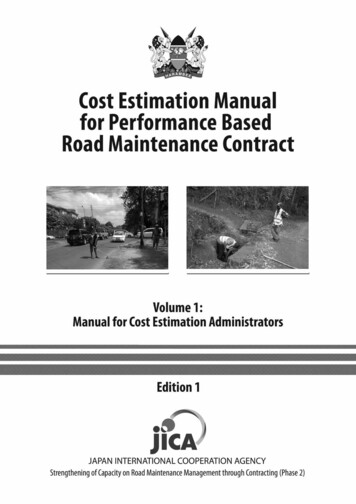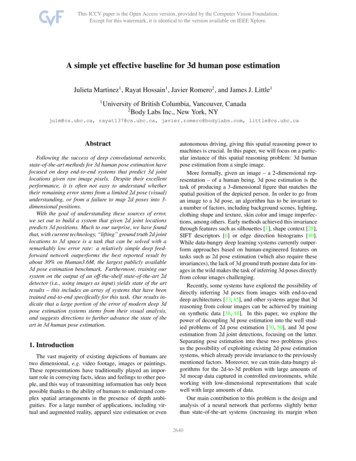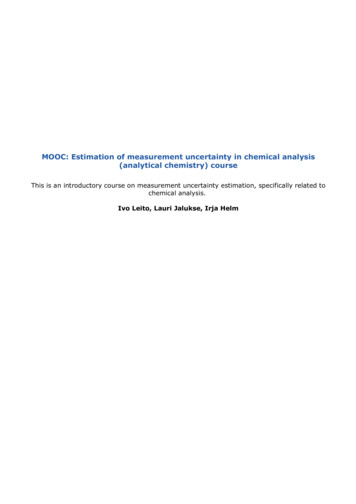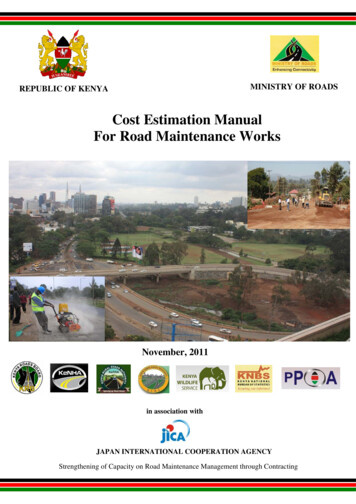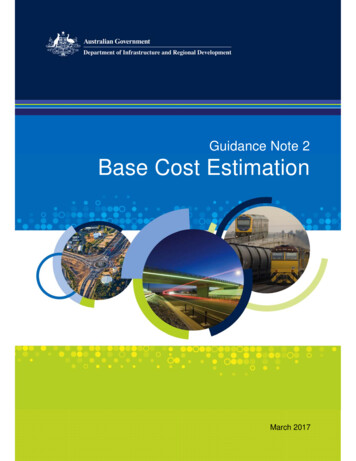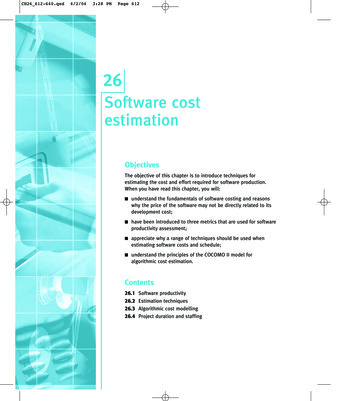
Transcription
CH26 612-640.qxd4/2/043:28 PMPage 61226Software costestimationObjectivesThe objective of this chapter is to introduce techniques forestimating the cost and effort required for software production.When you have read this chapter, you will: understand the fundamentals of software costing and reasonswhy the price of the software may not be directly related to itsdevelopment cost; have been introduced to three metrics that are used for softwareproductivity assessment; appreciate why a range of techniques should be used whenestimating software costs and schedule; understand the principles of the COCOMO II model foralgorithmic cost estimation.Contents26.126.226.326.4Software productivityEstimation techniquesAlgorithmic cost modellingProject duration and staffing
CH26 612-640.qxd4/2/043:28 PMPage 613Chapter 26 Software cost estimation613In Chapter 5, I introduced the project planning process where the work in a projectis split into a number of separate activities. This earlier discussion of project planning concentrated on ways to represent these activities, their dependencies and theallocation of people to carry out these tasks. In this chapter, I turn to the problemof associating estimates of effort and time with the project activities. Estimationinvolves answering the following questions:1.How much effort is required to complete each activity?2.How much calendar time is needed to complete each activity?3.What is the total cost of each activity?Project cost estimation and project scheduling are normally carried out together.The costs of development are primarily the costs of the effort involved, so the effortcomputation is used in both the cost and the schedule estimate. However, you mayhave to do some cost estimation before detailed schedules are drawn up. These initial estimates may be used to establish a budget for the project or to set a price forthe software for a customer.There are three parameters involved in computing the total cost of a softwaredevelopment project: Hardware and software costs including maintenanceTravel and training costsEffort costs (the costs of paying software engineers).For most projects, the dominant cost is the effort cost. Computers that are powerful enough for software development are relatively cheap. Although extensive travelcosts may be needed when a project is developed at different sites, the travel costs areusually a small fraction of the effort costs. Furthermore, using electronic communications systems such as e-mail, shared web sites and videoconferencing can significantlyreduce the travel required. Electronic conferencing also means that travelling time isreduced and time can be used more productively in software development. In one project where I worked, making every other meeting a videoconference rather than a faceto-face meeting reduced travel costs and time by almost 50%.Effort costs are not just the salaries of the software engineers who are involvedin the project. Organisations compute effort costs in terms of overhead costs wherethey take the total cost of running the organisation and divide this by the numberof productive staff. Therefore, the following costs are all part of the total effort cost:1.Costs of providing, heating and lighting office space2.Costs of support staff such as accountants, administrators, system managers,cleaners and technicians3.Costs of networking and communications
CH26 612-640.qxd6144/2/04Chapter 263:28 PM Page 614Software cost estimation4.Costs of central facilities such as a library or recreational facilities5.Costs of Social Security and employee benefits such as pensions and healthinsurance.This overhead factor is usually at least twice the software engineer’s salary, depending on the size of the organisation and its associated overheads. Therefore, if a company pays a software engineer 90,000 per year, its total costs are at least 180,000per year or 15,000 per month.Once a project is underway, project managers should regularly update their costand schedule estimates. This helps with the planning process and the effective useof resources. If actual expenditure is significantly greater than the estimates, thenthe project manager must take some action. This may involve applying for additional resources for the project or modifying the work to be done.Software costing should be carried out objectively with the aim of accurately predicting the cost of developing the software. If the project cost has been computed aspart of a project bid to a customer, a decision then has to be made about the price quotedto the customer. Classically, price is simply cost plus profit. However, the relationshipbetween the project cost and the price to the customer is not usually so simple.Software pricing must take into account broader organisational, economic, political and business considerations, such as those shown in Figure 26.1. Therefore,there may not be a simple relationship between the price to the customer for thesoftware and the development costs. Because of the organisational considerationsinvolved, project pricing should involve senior management (i.e., those who canmake strategic decisions), as well as software project managers.For example, say a small oil services software company employs 10 engineersat the beginning of a year, but only has contracts in place that require 5 membersof the development staff. However, it is Bidding for a very large contract with amajor oil company that requires 30 person years of effort over 2 years. The projectwill not start up for at least 12 months but, if granted, it will transform the financesof the small company. The oil services company gets an opportunity to bid on aproject that requires 6 people and has to be completed in 10 months. The costs (including overheads of this project) are estimated at 1.2 million. However, to improveits competitive position, the oil services company bids a price to the customer of 0.8 million. This means that, although it loses money on this contract, it can retainspecialist staff for more profitable future projects.26.1 Software productivityYou can measure productivity in a manufacturing system by counting the numberof units that are produced and dividing this by the number of person-hours required
CH26 612-640.qxd4/2/043:28 PMPage 61526.1Figure 26.1 Factorsaffecting softwarepricing Software productivity615FactorDescriptionMarket opportunityA development organisation may quote a low pricebecause it wishes to move into a new segment of thesoftware market. Accepting a low profit on one projectmay give the organisation the opportunity to make agreater profit later. The experience gained may also help itdevelop new products.Cost estimateuncertaintyIf an organisation is unsure of its cost estimate, it mayincrease its price by some contingency over and above itsnormal profit.Contractual termsA customer may be willing to allow the developer toretain ownership of the source code and reuse it in otherprojects. The price charged may then be less than if thesoftware source code is handed over to the customer.Requirements volatilityIf the requirements are likely to change, an organisationmay lower its price to win a contract. After the contract isawarded, high prices can be charged for changes to therequirements.Financial healthDevelopers in financial difficulty may lower their price togain a contract. It is better to make a smaller than normalprofit or break even than to go out of business.to produce them. However, for any software problem, there are many different solutions, each of which has different attributes. One solution may execute more efficiently while another may be more readable and easier to maintain. When solutionswith different attributes are produced, comparing their production rates is not reallymeaningful.Nevertheless, as a project manager, you may be faced with the problem of estimating the productivity of software engineers. You may need these productivity estimates to help define the project cost or schedule, to inform investment decisions orto assess whether process or technology improvements are effective.Productivity estimates are usually based on measuring attributes of the softwareand dividing this by the total effort required for development. There are two typesof metric that have been used:1.Size-related metrics These are related to the size of some output from an activity. The most commonly used size-related metric is lines of delivered sourcecode. Other metrics that may be used are the number of delivered object codeinstructions or the number of pages of system documentation.2.Function-related metrics These are related to the overall functionality of thedelivered software. Productivity is expressed in terms of the amount of useful
CH26 612-640.qxd6164/2/04Chapter 263:28 PM Page 616Software cost estimationfunctionality produced in some given time. Function points and object pointsare the best-known metrics of this type.Lines of source code per programmer-month (LOC/pm) is a widely used software productivity metric. You can compute LOC/pm by counting the total numberof lines of source code that are delivered, then divide the count by the total time inprogrammer-months required to complete the project. This time therefore includesthe time required for all other activities (requirements, design, coding, testing anddocumentation) involved in software development.This approach was first developed when most programming was in FORTRAN,assembly language or COBOL. Then, programs were typed on cards, with one statement on each card. The number of lines of code was easy to count: It correspondedto the number of cards in the program deck. However, programs in languages suchas Java or C consist of declarations, executable statements and commentary. Theymay include macro instructions that expand to several lines of code. There may bemore than one statement per line. There is not, therefore, a simple relationship betweenprogram statements and lines on a listing.Comparing productivity across programming languages can also give misleading impressions of programmer productivity. The more expressive the programminglanguage, the lower the apparent productivity. This anomaly arises because all software development activities are considered together when computing the development time, but the LOC metric applies only to the programming process. Therefore,if one language requires more lines than another to implement the same functionality, productivity estimates will be anomalous.For example, consider an embedded real-time system that might be coded in 5,000lines of assembly code or 1,500 lines of C. The development time for the variousphases is shown in Figure 26.2. The assembler programmer has a productivity of714 lines/month and the high-level language programmer less than half of this—300 lines/month. Yet the development costs for the system developed in C are lowerand it is delivered earlier.An alternative to using code size as the estimated product attribute is to use somemeasure of the functionality of the code. This avoids the above anomaly, as functionality is independent of implementation language. MacDonell (MacDonell,1994) briefly describes and compares several function-based measures. The best knownof these measures is the function-point count. This was proposed by Albrecht (Albrecht,1979) and refined by Albrecht and Gaffney (Albrecht and Gaffney, 1983). Garmusand Herron (Garmus and Herron, 2000) describe the practical use of function pointsin software projects.Productivity is expressed as the number of function points that are implementedper person-month. A function point is not a single characteristic but is computedby combining several different measurements or estimates. You compute the totalnumber of function points in a program by measuring or estimating the followingprogram features:
CH26 612-640.qxd4/2/043:28 PMPage 61726.1Figure 26.2 Systemdevelopment timesAssembly codeHigh-level languageAssembly codeHigh-level language Software ation3 weeks3 weeks5 weeks5 weeks8 weeks4 weeks10 weeks6 weeks2 weeks2 weeksSizeEffortProductivity5000 lines1500 lines28 weeks20 weeks714 lines/month300 lines/monthexternal inputs and outputs;user interactions;external interfaces;files used by the system.Obviously, some inputs and outputs, interactions. and so on are more complexthan others and take longer to implement. The function-point metric takes this intoaccount by multiplying the initial function-point estimate by a complexity-weighting factor. You should assess each of these features for complexity and then assignthe weighting factor that varies from 3 (for simple external inputs) to 15 for complex internal files. Either the weighting values proposed by Albrecht or values basedon local experience may be used.You can then compute the so-called unadjusted function-point count (UFC) bymultiplying each initial count by the estimated weight and summing all values.UFC (number of elements of given type) (weight)You then modify this unadjusted function-point count by additional complexityfactors that are related to the complexity of the system as a whole. This takes intoaccount the degree of distributed processing, the amount of reuse, the performance,and so on. The unadjusted function-point count is multiplied by these project complexity factors to produce a final function-point count for the overall system.Symons (Symons, 1988) notes that the subjective nature of complexity estimatesmeans that the function-point count in a program depends on the estimator. Differentpeople have different notions of complexity. There are therefore wide variations infunction-point count depending on the estimator’s judgement and the type of systembeing developed. Furthermore, function points are biased towards data-processingsystems that are dominated by input and output operations. It is harder to estimatefunction-point counts for event-driven systems. For this reason, some people thinkthat function points are not a very useful way to measure software productivity (Fureyand Kitchenham, 1997; Armour, 2002). However, users of function points argue that,
CH26 612-640.qxd6184/2/04Chapter 263:28 PM Page 618Software cost estimationin spite of their flaws, they are effective in practical situations (Banker, et al., 1993;Garmus and Herron, 2000).Object points (Banker, et al., 1994) are an alternative to function points. Theycan be used with languages such as database programming languages or scriptinglanguages. Object points are not object classes that may be produced when an objectoriented approach is taken to software development. Rather, the number of objectpoints in a program is a weighted estimate of:1.The number of separate screens that are displayed Simple screens count as 1object point, moderately complex screens count as 2, and very complex screenscount as 3 object points.2.The number of reports that are produced For simple reports, count 2 objectpoints, for moderately complex reports, count 5, and for reports that are likelyto be difficult to produce, count 8 object points.3.The number of modules in imperative programming languages such as Java orC that must be developed to supplement the database programming codeEach of these modules counts as 10 object points.Object points are used in the COCOMO II estimation model (where they are calledapplication points) that I cover later in this chapter. The advantage of object pointsover function points is that they are easier to estimate from a high-level softwarespecification. Object points are only concerned with screens, reports and modulesin conventional programming languages. They are not concerned with implementation details, and the complexity factor estimation is much simpler.If function points or object points are used, they can be estimated at an earlystage in the development process before decisions that affect the program size havebeen made. Estimates of these parameters can be made as soon as the external interactions of the system have been designed. At this stage, it is very difficult to produce an accurate estimate of the size of a program in lines of source code.Function-point and object-point counts can be used in conjunction with lines ofcode-estimation models. The final code size is calculated from the number of function points. Using historical data analysis, the average number of lines of code, AVC,in a particular language required to implement a function point can be estimated.Values of AVC vary from 200 to 300 LOC/FP in assembly language to 2 to 40LOC/FP for a database programming language such as SQL. The estimated codesize for a new application is then computed as follows:Code size AVC Number of function pointsThe programming productivity of individuals working in an organisation isaffected by a number of factors. Some of the most important of these are summarisedin Figure 26.3. However, individual differences in ability are usually more significant than any of these factors. In an early assessment of productivity, Sackman etal. (Sackman, et al., 1968) found that some programmers were more than 10 times
CH26 612-640.qxd4/2/043:28 PMPage 61926.1Figure 26.3 Factorsaffecting softwareengineeringproductivity Software productivity619FactorDescriptionApplication domainexperienceKnowledge of the application domain is essential foreffective software development. Engineers who alreadyunderstand a domain are likely to be the most productive.Process qualityThe development process used can have a significant effecton productivity. This is covered in Chapter 28.Project sizeThe larger a project, the more time required for teamcommunications. Less time is available for development soindividual productivity is reduced.Technology supportGood support technology such as CASE tools andconfiguration management systems can improveproductivity.Working environmentAs I discussed in Chapter 25, a quiet working environmentwith private work areas contributes to improvedproductivity.more productive than others. My experience is that this is still true. Large teamsare likely to have a mix of abilities and experience and so will have ‘average’ productivity. In small teams, however, overall productivity is mostly dependent on individual aptitudes and abilities.Software development productivity varies dramatically across applicationdomains and organisations. For large, complex, embedded systems, productivity hasbeen estimated to be as low as 30 LOC/pm. For straightforward, well-understoodapplication systems, written in a language such as Java, it may be as high as 900LOC/pm. When measured in terms of object points, Boehm et al. (Boehm, et al.,1995) suggest that productivity varies from 4 object points per month to 50 per month,depending on the type of application, tool support and developer capability.The problem with measures that rely on the amount produced in a given timeperiod is that they take no account of quality characteristics such as reliability andmaintainability. They imply that more always means better. Beck (Beck, 2000), inhis discussion of extreme programming, makes an excellent point about estimation.If your approach is based on continuous code simplification and improvement, thencounting lines of code doesn’t mean much.These measures also do not take into account the possibility of reusing the software produced, using code generators and other tools that help create the software.What we really want to estimate is the cost of deriving a particular system withgiven functionality, quality, performance, maintainability, and so on. This is onlyindirectly related to tangible measures such as the system size.As a manager, you should not use productivity measurements to make hasty judgements about the abilities of the engineers on your team. If you do, engineers maycompromise on quality in order to become more ‘productive’. It may be the case
CH26 612-640.qxd6204/2/04Chapter 263:28 PM Page 620Software cost estimationthat the ‘less-productive’ programmer produces more reliable code—code that iseasier to understand and cheaper to maintain. You should always, therefore, thinkof productivity measures as providing partial information about programmer productivity. You also need to consider other information about the quality of the programs that are produced.26.2 Estimation techniquesThere is no simple way to make an accurate estimate of the effort required to developa software system. You may have to make initial estimates on the basis of a highlevel user requirements definition. The software may have to run on unfamiliar computers or use new development technology. The people involved in the project andtheir skills will probably not be known. All of these mean that it is impossible toestimate system development costs accurately at an early stage in a project.Furthermore, there is a fundamental difficulty in assessing the accuracy of different approaches to cost-estimation techniques. Project cost estimates are often selffulfilling. The estimate is used to define the project budget, and the product is adjustedso that the budget figure is realised. I do not know of any controlled experimentswith project costing where the estimated costs were not used to bias the experiment. A controlled experiment would not reveal the cost estimate to the project manager. The actual costs would then be compared with the estimated project costs.However, such an experiment is probably impossible because of the high costs involvedand the number of variables that cannot be controlled.Nevertheless, organisations need to make software effort and cost estimates. Todo so, one or more of the techniques described in Figure 26.4 may be used (Boehm,1981). All of these techniques rely on experience-based judgements by project managers who use their knowledge of previous projects to arrive at an estimate of theresources required for the project. However, there may be important differencesbetween past and future projects. Many new development methods and techniqueshave been introduced in the last 10 years. Some examples of the changes that mayaffect estimates based on experience include:1.Distributed object systems rather than mainframe-based systems2.Use of web services3.Use of ERP or database-centred systems4.Use of off-the-shelf software rather than original system development5.Development for and with reuse rather than new development of all parts of asystem
CH26 612-640.qxd4/2/043:28 PMPage 62126.2Figure 26.4 Costestimationtechniques Estimation techniquesTechniqueDescriptionAlgorithmic costmodellingA model is developed using historical cost information thatrelates some software metric (usually its size) to the projectcost. An estimate is made of that metric and the modelpredicts the effort required.Expert judgementSeveral experts on the proposed software developmenttechniques and the application domain are consulted. Theyeach estimate the project cost. These estimates are comparedand discussed. The estimation process iterates until an agreedestimate is reached.Estimation byanalogyThis technique is applicable when other projects in the sameapplication domain have been completed. The cost of a newproject is estimated by analogy with these completed projects.Myers (Myers, 1989) gives a very clear description of thisapproach.Parkinson’s LawParkinson’s Law states that work expands to fill the timeavailable. The cost is determined by available resources ratherthan by objective assessment. If the software has to bedelivered in 12 months and 5 people are available, the effortrequired is estimated to be 60 person-months.Pricing to winThe software cost is estimated to be whatever the customerhas available to spend on the project. The estimated effortdepends on the customer’s budget and not on the softwarefunctionality.6216.Development using scripting languages such as TCL or Perl (Ousterhout, 1998)7.The use of CASE tools and program generators rather than unsupported software development.If project managers have not worked with these techniques, their previous experience may not help them estimate software project costs. This makes it more difficult for them to produce accurate costs and schedule estimates.You can tackle the approaches to cost estimation shown in Figure 26.4 usingeither a top-down or a bottom-up approach. A top-down approach starts at the system level. You start by examining the overall functionality of the product and howthat functionality is provided by interacting sub-functions. The costs of system-levelactivities such as integration, configuration management and documentation are takeninto account.The bottom-up approach, by contrast, starts at the component level. The systemis decomposed into components, and you estimate the effort required to developeach of these components. You then add these component costs to compute the effortrequired for the whole system development.
CH26 612-640.qxd6224/2/04Chapter 263:28 PM Page 622Software cost estimationThe disadvantages of the top-down approach are the advantages of the bottom-upapproach and vice versa. Top-down estimation can underestimate the costs of solving difficult technical problems associated with specific components such as interfaces to nonstandard hardware. There is no detailed justification of the estimate thatis produced. By contrast, bottom-up estimation produces such a justification and considers each component. However, this approach is more likely to underestimate thecosts of system activities such as integration. Bottom-up estimation is also more expensive. There must be an initial system design to identify the components to be costed.Each estimation technique has its own strengths and weaknesses. Each uses different information about the project and the development team, so if you use a single model and this information is not accurate, your final estimate will be wrong.For large projects, therefore, you should use several cost estimation techniques andcompare their results. If these predict radically different costs, you probably do nothave enough information about the product or the development process. Youshould look for more information about the product, process or team and repeat thecosting process until the estimates converge.These estimation techniques are applicable where a requirements document forthe system has been produced. This should define all users and system requirements.You can therefore make a reasonable estimate of the system functionality that is tobe developed. In general, large systems engineering projects will have such arequirements document.However, in many cases, the costs of many projects must be estimated usingonly incomplete user requirements for the system. This means that the estimatorshave very little information with which to work. Requirements analysis and specification is expensive, and the managers in a company may need an initial cost estimate for the system before they can have a budget approved to develop more detailedrequirements or a system prototype.Under these circumstances, “pricing to win” is a commonly used strategy. Thenotion of pricing to win may seem unethical and unbusinesslike. However, it doeshave some advantages. A project cost is agreed on the basis of an outline proposal.Negotiations then take place between client and customer to establish the detailedproject specification. This specification is constrained by the agreed cost. Thebuyer and seller must agree on what is acceptable system functionality. The fixedfactor in many projects is not the project requirements but the cost. The requirements may be changed so that the cost is not exceeded.For example, say a company is bidding for a contract to develop a new fuel delivery system for an oil company that schedules deliveries of fuel to its service stations. There is no detailed requirements document for this system so the developersestimate that a price of 900,000 is likely to be competitive and within the oil company’s budget. After they are granted the contract, they negotiate the detailed requirements of the system so that basic functionality is delivered; then they estimate theadditional costs for other requirements. The oil company does not necessarily losehere because it has awarded the contract to a company that it can trust. The additional requirements may be funded from a future budget, so that the oil company’sbudgeting is not disrupted by a very high initial software cost.
CH26 612-640.qxd4/2/043:28 PMPage 62326.3 Algorithmic cost modelling62326.3 Algorithmic cost modellingAlgorithmic cost modelling uses a mathematical formula to predict project costs basedon estimates of the project size, the number of software engineers, and other process and product factors. An algorithmic cost model can be built by analysing thecosts and attributes of completed projects and finding the closest fit formula to actualexperience.Algorithmic cost models are primarily used to make estimates of software development costs, but Boehm (Boehm, et al., 2000) discusses a range of other uses foralgorithmic cost estimates, including estimates for investors in software companies,estimates of alternative strategies to help assess risks, and estimates to inform decisions about reuse, redevelopment or outsourcing.In its most general form, an algorithmic cost estimate for software cost can beexpressed as:Effort A SizeB MA is a constant factor that depends on local organisational practices and the typeof software that is developed. Size may be either an assessment of the code size ofthe software or a functionality estimate expressed in function or object points. Thevalue of exponent B usually lies between 1 and 1.5. M is a multiplier made by combining process, product and development attributes, such as the dependabilityrequirements for the software and the experience of the development teamMost al
616 Chapter 26 Software cost estimation functionality produced in some given time. Function points and object points are the best-known metrics of this type. Lines of source code per programmer-month (LOC/pm) is a widely used soft-
